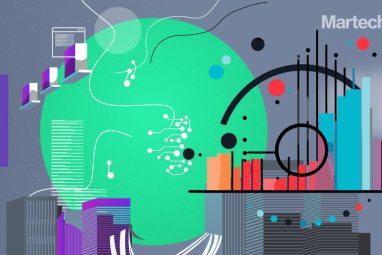Augmented Analytics: Generating AI-Driven Marketing Intelligence at Scale in a Post COVID-19 World
In 2017, Gartner predicted Augmented Analytics to be the future of data. By 2019 – in less than two years – it emerged as the number 1 trend in data analytics. As per research published by Allied Market Research this year, the global market for Augmented Analytics will reach $ 29.86 billion by 2025. As […]
Topics
In 2017, Gartner predicted Augmented Analytics to be the future of data. By 2019 – in less than two years – it emerged as the number 1 trend in data analytics. As per research published by Allied Market Research this year, the global market for Augmented Analytics will reach $ 29.86 billion by 2025.
As a direct fallout of the ongoing global COVID-19 crisis, those promising projections will be adversely impacted. But, with businesses continuing to grapple with their data unification, stitching, and actionable insight-generation challenges, Augmented Analytics promises to be a strong antidote in a post-COVID-19 landscape.
Big Data < Data-Driven Insights
Data-driven insights are no longer just good-to-have; they are critical for businesses to stay ahead of the curve. Most future-ready organisations today have embraced data analytics to deepen their understanding of customers and drive bottom-line growth. The problem is, their ability to leverage the power of data is severely limited, leading to a failure of data analytics projects.
Sample this: Gartner estimates an incredible 60% of all big data projects fail!
Data, by itself, holds no value for a business. Let’s say a company’s data reveals that sales figures are dropping by 5% every month. But what does that mean? This decline could be attributed to a failure of advertising methods, industry trends, or a basket of other causative factors.
What is required is a granular deep-dive into the issue to uncover the real factor behind the decline in sales. For instance, you may realise that your paid ads are less effective and need a different approach. Now, you have an actionable insight that tells you exactly what you need to do to address this.
The lesson: You need actionable insights, not just information at hand. That’s not enough for effective decision-making.
A data analytics project involves several processes – data aggregation, extraction, cleansing, pattern analysis, insights-generation, to name a few. While the process itself isn’t as complicated, the key challenge is generating the right insights.
With data scientists in scant (and expensive!) supply, businesses need an advanced yet affordable tech tool for data analysis to achieve business intelligence at scale. And, that’s where Augmented Analytics comes into the picture.
What is Augmented Analytics?
Augmented Analytics (AA) enables businesses to make sense of massive amounts of unstructured data. It combines Artificial Intelligence (AI), Machine Learning (ML), and Natural Language Processing (NLP) to automate the process of insight-generation and extraction from such data.
Also read: How AI is Improving Predictive Analytics
The AA-driven tools organise, manage, filter, and analyse datasets to produce actionable insights. This high degree of automation significantly reduces the time taken to convert this data into digestible information. Owing to the reduced manual involvement and dependence, businesses can rapidly analyse data at scale, and quickly identify patterns and trends.
Let’s Get Slightly Technical
AI has been underscored umpteen times now: Data is the growth engine for any customer-focused business. By automating a crucial part of the insight-generation process, Augmented Analytics fuels this engine at an accelerated rate.
Gartner outlines the different stages of Augmented Analytics as follows:
-
Data preparation and discovery.
Currently, most existing Augmented Analytics technologies lie in this stage. Here, the algorithm’s primary job is to automate data preparation tasks such as cleaning, labelling, collection, etc. At this stage, business stakeholders can use ML to automatically detect, visualise, and present relevant findings without having to build complicated models or algorithms
-
Signal detection
At this stage, the analytics algorithm is able to detect true signals in data with a good measure of reliability. But, will be unable to connect the discoveries with real-time business actions or situations. So, human intervention – in the form of data scientists – is essential to transform such discoveries into actionable business insights. The upside is that the time spent on generating individual insights is reduced drastically
-
Insight generation
This is where the Augmented Analytics engine directly interfaces with executives with almost no manual intervention. The algorithm harnesses its knowledge of past business cases to connect trends in the data with broader business contexts. It can then predict and recommend future action steps based on these insights. The engine can also track the implementation of such actions and offer additional insights to businesses to optimise operational effectiveness.
Marketers Have a Lot to Benefit. True Story!
Beyond the benefits of increased speed and accuracy of insight-generation and predictive action recommendations, reduced dependency on manual intervention, decision-making biases, and lower costs – Augmented Analytics benefits multiple departments across a business – including marketing.
Here’s how:
-
Generate real-time insights to boost customer engagement and retention:
For effective decision-making, marketers require granular insights at speed. Given that customers today expect personalised experiences across platforms, channels, and devices; marketers need a real-time view of their individual needs and behaviours to deliver what they’re looking for, ASAP.
Augmented Analytics tools allow marketers to do just this, without wasting any time. They quickly organise data and run an analysis using a combination of ML and NLP. Interacting with vast quantities of data, they uncover patterns, trends, and anomalies – information that is gold to marketers.
For instance, augmented analytics may identify the channels a specific customer segment engages with the most and the types of ads that receive a maximum response. With this insight, marketers know precisely where and how to reach customers to elicit the desired action. They can also help automate the optimisation of channel-spends based on the ROI of each channel deployed across relevant customer segments.
Additionally, augmented analytics can help with customer retention too. For instance, the data uncovered by Augmented Analytics tools can tell marketers not just where customers are spending their time but also how to target them better. This becomes the foundation for contextualised campaigns to suit individualised customer preferences; thereby, building repeat purchase behaviour and loyalty over a period of time.
-
Measure multi-channel performance effectively:
Augmented Analytics tools can measure the outcomes they drive. Marketers can, thus, evaluate progress and measure performance through an analysis of dynamic analysis of customer segments, channels, campaigns, etc.
These performance metrics feed right back into marketers’ decision-making with regards to optimising customer journeys, campaign content/creatives, channel spends, segmentation factors, etc.
-
Undertake data-driven decision-making:
Marketers can leverage the data visualisation capabilities of Augmented Analytics to understand and share findings in a simple format with their C-Suite. Equipped with these actionable insights, businesses can participate in data-driven decision making, especially when all functional heads are on the same page.
The Road Ahead: There’s Something for Everyone
Augmented Analytics is well on its way to transforming the way businesses analyse immense volumes of data. Marketers, in particular, have much to gain. They can finally regain control of massive sets of data and deliver AI-led personalised customer experiences at scale.
In the present landscape, businesses are producing so much data that it has become impossible for manual teams to deal with it on their own. Manual data exploration always runs the risk of missing key insights. And, that proverbial needle in the haystack can mean the difference between opportunities grasped and lost.
With augmented analytics, organisations have a tool to explore all possible hypotheses from the collected data and automate a great deal of data science tasks. When Augmented Analytics and Data Science work together, data insights will become democratised; i.e. become available to a vast pool of internal business stakeholders.
At a time when customer behaviour is already undergoing subtle and not-so-subtle changes, businesses and marketers need to double-down on the delivery of delightful customer experiences. Identifying cutting-edge, actionable insights, backed by Augmented Analytics, can be a real gamechanger, especially with digital businesses, across industries, gunning for the same limited customer mindshare, screen-share, and wallet-share.








































































































